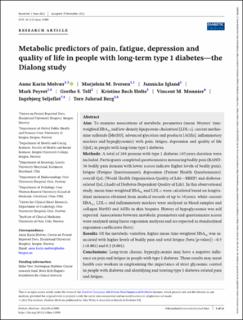| dc.contributor.author | Molvær, Anne Karin | |
| dc.contributor.author | Iversen, Marjolein M. | |
| dc.contributor.author | Igland, Jannicke | |
| dc.contributor.author | Peyrot, Mark | |
| dc.contributor.author | Tell, Grethe S. | |
| dc.contributor.author | Holte, Kristine Bech | |
| dc.contributor.author | Monnier, Vincent M. | |
| dc.contributor.author | Seljeflot, Ingebjørg | |
| dc.contributor.author | Berg, Tore Julsrud | |
| dc.date.accessioned | 2022-12-30T14:05:28Z | |
| dc.date.available | 2022-12-30T14:05:28Z | |
| dc.date.created | 2022-12-16T14:00:13Z | |
| dc.date.issued | 2022 | |
| dc.identifier.issn | 0742-3071 | |
| dc.identifier.uri | https://hdl.handle.net/11250/3040114 | |
| dc.description.abstract | Aim
To examine associations of metabolic parameters (mean 30 years' time-weighted HbA1c and low-density lipoprotein-cholesterol [LDL-c], current methionine sulfoxide [MetSO], advanced glycation end products [AGEs], inflammatory markers and hypoglycaemia) with pain, fatigue, depression and quality of life (QoL) in people with long-term type 1 diabetes.
Methods
A total of 104 persons with type 1 diabetes ≥45 years duration were included. Participants completed questionnaires measuring bodily pain (RAND-36 bodily pain domain with lower scores indicate higher levels of bodily pain), fatigue (Fatigue Questionnaire), depression (Patient Health Questionnaire), overall QoL (World Health Organization Quality of Life—BREF) and diabetes-related QoL (Audit of Diabetes-Dependent Quality of Life). In this observational study, mean time-weighted HbA1c and LDL-c were calculated based on longitudinal measures obtained from medical records of up to 34 years, while current HbA1c, LDL-c and inflammatory markers were analysed in blood samples and collagen MetSO and AGEs in skin biopsies. History of hypoglycaemia was self reported. Associations between metabolic parameters and questionnaire scores were analysed using linear regression analyses and are reported as standardized regression coefficients (beta).
Results
Of the metabolic variables, higher mean time-weighted HbA1c was associated with higher levels of bodily pain and total fatigue (beta [p-value]) −0.3 (<0.001) and 0.2 (0.001).
Conclusions
Long-term chronic hyperglycaemia may have a negative influence on pain and fatigue in people with type 1 diabetes. These results may assist health care workers in emphasizing the importance of strict glycaemic control in people with diabetes and identifying and treating type 1 diabetes-related pain and fatigue. | en_US |
| dc.language.iso | eng | en_US |
| dc.publisher | Wiley | en_US |
| dc.rights | Attribution-NonCommercial-NoDerivatives 4.0 Internasjonal | * |
| dc.rights.uri | http://creativecommons.org/licenses/by-nc-nd/4.0/deed.no | * |
| dc.title | Metabolic predictors of pain, fatigue, depression and quality of life in people with long-term type 1 diabetes—the Dialong study | en_US |
| dc.type | Journal article | en_US |
| dc.type | Peer reviewed | en_US |
| dc.description.version | publishedVersion | en_US |
| dc.rights.holder | Copyright 2022 The Author(s) | en_US |
| dc.source.articlenumber | e15009 | en_US |
| cristin.ispublished | true | |
| cristin.fulltext | original | |
| cristin.qualitycode | 1 | |
| dc.identifier.doi | 10.1111/dme.15009 | |
| dc.identifier.cristin | 2094436 | |
| dc.source.journal | Diabetic Medicine | en_US |
| dc.identifier.citation | Diabetic Medicine. 2022, e15009. | en_US |

